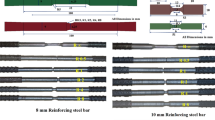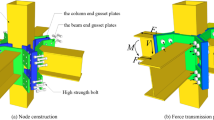Abstract
When deformed bars are anchored in concrete, this gives rise not only to bond stresses but also to splitting stresses. To measure the splitting stresses, tests were carried out in which a reinforcement bar was pulled out of a concrete cylinder surrounded by a thin steel tube. The tangential strains in the steel tube were measured, together with the applied load and slip. In five tests, specimens were loaded by monotonically increasing the load, while nine other tests were subjected to reversed cyclic loading. All of the tests resulted in pull-out failures. The results from the monotonic tests indicate that the splitting stresses decreased after the maximum load had been obtained, however not as much as the load decreased. The results from the cyclic tests show a typical response for bond in cyclic loading. When there was almost no bond capacity left the measured strain in the steel tubes stabilised and remained more or less unaffected by the last load cycles. The test results give valuable information about the splitting stresses that result from anchorage of reinforcement bars in concrete. These test results can be useful as a reference when calibrating models of the bond mechanism, and give a better understanding of the bond mechanism.
Résumé
Lorsque des barres déformées sont ancrées dans du béton, cela entraîne une augmentation non seulement des contraintes de liaison mais aussi des contraintes de fractionnement. Pour mesurer les contraintes de fractionnement, les essais consistaient à tirer la barre d'armature d'un cylindre de béton entouré d'un fin tube d'acier. Nous avons mesuré les contraintes tangentielles dans le tube d'acier ainsi que la charge et le glissement appliqués. Lors de cinq essais, les spécimens ont été chargés en augmentant la charge de manière monotone, alors que neuf autres essais ont été soumis à une charge cyclique inversée. Tous les essais ont abouti à des défauts de décrochage. Les résultats des essais monotones indiquent que les contraintes de fractionnement ont diminué après que la charge maximum ait été obtenue, pas autant toutefois que lorsque la charge a diminué. Les résultats des essais cycliques indiquent une réponse typique de la liaison dans la charge cyclique. Quand il ne restait que peu de capacité de liaison, la contrainte mesurée dans les tubes d'acier s'est stabilisée et est restée très peu affectée par les derniers cycles de charge. Les résultats des essais fournissent une information précieuse sur les contraintes de division qui résultent de l'ancrage de barres d'armature dans le béton. Ces résultats peuvent servir de référence lors du calibrage des modèles du mécanisme de liaison et donnent une meilleure compréhension du mécanisme de liaison.
Similar content being viewed by others
References
Tepfers, R. and Olsson, P.-Å., ‘Ring test for evaluation of bond properties of reinforcing bars’, in ‘Bond in Concrete’, Proceedings of an International Conference, Riga, 1992, (CEB, Riga, 1992), 1-89–1-99.
Malvar, L. J., ‘Confinement stress dependent bond behavior, part I: Experimental investigation’, in ‘Bond in Concrete’, Proceedings of an International Conference, Riga, 1992, (CEB, Riga, 1992) 1-79–1-88.
Eligehausen, R., Popov, E. P. and Bertero, V. V., ‘Local bond stress-slip relationships of deformed bars under generalized excitations’ v.4, Proceedings of the Seventh European Conference on Earthquake Engineering, Athens, Sept. 1982, 69–80.
Balázs, G. and Koch, R., ‘Bond characteristics under reversed cyclic loading’,Otto Graf Journal 6 (1995) 47–62.
Magnusson, J., ‘Bond and Anchorage of Deformed Bars in High-Strength Concrete’, Licentiate Thesis, Publication 97:1. (Division of Concrete Structures, Chalmers University of Technology, Göteborg, 1997).
Åkesson, M., ‘Fracture Mechanics Analysis of the Transmission Zone in Prestressed Hollow Core Slabs’, Licentiate Thesis, Publication 93:5. (Division of Concrete Structures, Chalmers University of Technology, Göteborg, 1993).
Lundgren, K. and Gylltoft, K., ‘A model for the bond between concrete and reinforcement’,Magazine of Concrete Research 52 (2000) 53–63.
Lundgren, K. ‘Steel-Encased Pull-Out Tests Subjected to Reversed Cyclic Loading’, Report 98:9. (Division of Concrete Structures, Chalmers University of Technology, Göteborg, 1998).
Lundgren, K., ‘Modelling of Bond: Theoretical Model and Analyses’, Report 99:5. (Division of Concrete Structures, Chalmers University of Technology, Göteborg, 1999).
Author information
Authors and Affiliations
Rights and permissions
About this article
Cite this article
Lundgren, K. Pull-out tests of steel-encased specimens subjected to reversed cyclic loading. Mat. Struct. 33, 450–456 (2000). https://doi.org/10.1007/BF02480665
Received:
Accepted:
Issue Date:
DOI: https://doi.org/10.1007/BF02480665




